| The following page is under construction.
Please do not edit or alter this article in any way while this template is active. All unauthorized edits may be reverted on the admin's discretion. Propose any changes to the talk page. |

Preface
What this article, and all following articles related to this subject, postulates upon is the perceivably altered North America due to an infectious and highly communicable pathogen that has resulted in over 82% of the continent's population developing Diabetes mellitus type 2, otherwise more commonly known as Type II Diabetes. What this timeline is meant to represent is the gradual effects, both minor and major in divergence, that can occur from a singular and solidity entity. In this case: Where Type II Diabetes becomes a way of life for the majority.

The initial impact of the Coxsackie virus did not stir headlines in medical journals, rather public newspapers such the New York Times (Oct. 3rd, 1903)
The Point of Divergence would be an ambiguous one, centrally fixed within the first few of 1903, where an enterovirus, mutated from the Coxsackie B virus, originates from the Northeastern area of the United States. Several relatively small outbreaks occur, then by the end of the year, half of the population of United States is affected. The virus, dubbed Coxsackie B5, spreads continuously for over sixty years until an eradicative solution emerges in June 5, 1969; discovered by Dr. Heath Gorges, member of a research group headed by Luther Leonidas Terry, the ninth and incumbent Surgeon General at the time.
Discovery and Reaction[]
On the most pleasant of mornings, the news produced fickle gossip and rumors amongst the townsfolk of Putnam, Connecticut that three of their citizens, which had just returned from a trip to Frederick, Maryland had come down with the strangest of illnesses. As far as the local doctors where concerned, this was cause for alarm, due to the fact that the symptoms including fatigue, high fever, sweating, vomiting, and ever decreasing life signs gave this occurrence the basis for medical interest. On August 17, 1903, John, Joseph, and Mary Bearer, siblings they were, became the first victims of what would soon become the most affecting and costly epidemics of the 20th century. Within two weeks later, near half the community was suffering from this yet unknown pathogen.
The New York Times reported the situation in Putnam on October 3, 1903, to an easily perplexed public. The cover story featured stark imagery of the town's residents bedridden in rows, within some makeshift hospital. Fears of an epidemic grew strong, and by the time the virus had reached neighboring New York State, pandemonium had struck the city and nearby communities. Accounts of men choosing to urinate in the streets, rather than in a public toilet in fear of contracting the disease from other men, are given; along with reports of locking coworkers in cupboards for having any signs of illness. However, the virus truly did have an impact, as it made more than half the city sick within months. The workforce, unable to man the factories and plants, caused the economy to grind to halt and the city suffered major blackouts for the ensuing months.
It had been discovered though that the virus, contrary to public perception, was not inevitably fatal, or some representation of the Bubonic Plague. In New Haven, Connecticut, the Yale Hospital had surveyed 251 patients, and found that only 7 had died, with seemingly a high recovery rate for those who survived. However, the virus was debilitating afterwards, and further examination of the patients showed that within 80-90% prevalence, their pancreas' beta cells had been near completely wiped out, halting the production of sufficient insulin and effectively rendering the victims diabetic. By the winter of 1903, the United States Public Health Services, under the oversight of President Roosevelt, acted upon the matter by issuing public notices in over 2,500 communities across the nation, informing on what precautions to take against the virus. At this stage, the virus had spread to all 45 states and resulting territories, with outbreaks occurring in Canada, Mexico and Europe, leaving over 25 million affected.
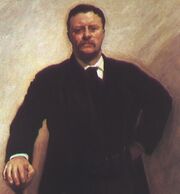
Theodore Roosevelt became renowned for his combative efforts against the Coxsackie epidemic, which proved largely successful
However, this was to be a defining moment for the presidency of Theodore Roosevelt, as he would gain re-election twice by the support of his healthcare plans for the American population. After conferring with numerous leading medical practitioners, he and the Public Health Services issued a program under the newly passed Diabetes Assistance Act of 1903, which would offer "service to those directly affected by this epidemic at no cost or disadvantage to the recipient" (page 2). By Summer of 1904, the program had assisted 55 million people successfully, and Roosevelt was re-elected by a major landslide in the elections that fall. Roosevelt would go on to pass three more acts in attempts to offer universal healthcare to every American citizen, before his unfortunate fatal heart attack in 1914 after leaving the presidency for the longest serving term.
| “ | One cannot expect our great nation to overcome this spreading disaster, if that 'one' is already thinking of seeking refugee in another country. | ” |
–Theodore Roosevelt, Presidential Address of December 31, 1903 | ||
Formation and Development of Communist Mexico[]
- Main Article: People's Federal Republic of Mexico
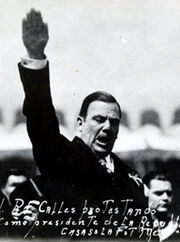
Calles' strong will to stay true to his own polices was seen by many to be his weakness when it came to poor political planing
Upon an obvious electoral fraud, Porfirio Díaz faced rebellion in his sixth presidential term which came in the form of the 1910 Mexican Revolution, led by Francisco I. Madero. Díaz was removed from his office in 1911, and Madero was soon elected president. However, the emerging "Diabetic Plague" put strain on the country's underprivileged healthcare system, and soon lead to the economy being regulated. In 1912, 300,000 Mexican people suffered inadequate medication and died, with more than 500,000 disabled. Madero resigned the following year in 1913 amid strong public opposition for his failure to prevent such casualties in the epidemic. Venustiano Carranza replaced his revolutionary associate, yet was overthrown and murdered in a coup d'état three years later, directed by conservative general Victoriano Huerta, before being able to institute governmental coverage for Mexican peasants. That event ignited the civil war, involving figures such as Francisco Villa and Emiliano Zapata, who formed their own forces.
The civil war proved unsuccessful, following the untimely death of Villa by Huerta's forces and the capture and execution of Zapata. In the ensuing years, thousands continued to perish due to Huerta's unconformity and apathy, leading major political dissidents in support of the Mexican Communist Party, upon hearing of the success of the Bolshevik Revolution in Russia. Álvaro Obregón sought the appeal of the party, and proceeded to overthrow Huerta in 1921. However, Obregón afterwards pledged loyalty to Laborist Party, and his policies lead to more social despondence.
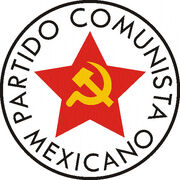
The logo of Mexican Communist Party, the leading party in the Mexican parliament since 1961
In 1928, Plutarco Elías Calles succeeded Obregón after being assassinated by a disgruntled doctor. Calles decisively planed to assist the public by constructing a health care system similar to that of Carranza's initial plan. However, it became an eventual failure, as many people throughout the Great Depression continued to lack proper medical support. In 1938, upon the then-controversial visitation of Soviet Ambassador Leon Trotsky, the MCP had found little enforcement of their ambitions, considering the heavy comments and severe criticism they had received from the ruling party. During his stay, Trotsky organized a public protest against the current government and sponsored any public interest in Leninism, and the teachings of Karl Marx, in front of Catedral Metropolitana on the afternoon of July 6. The protest stirred action from the government in the form of armed guards and police riot squad, which then took to breaking up the mass demonstration in what become known as the Weeping Saints Massacre, as it was described later by a major newsletter publication, leaving over 150 dead and hundreds wounded. Trotsky was subsequently arrested by the police force and held in federal prison for a period of two years, before the Soviet Union struck a deal for his release by the exoneration of influential Mexican prisoner within the country. Trotsky later became Premier, and continued to support the emergence of an integrated communist government within Mexico. The Mexican Communist Party slowly gathering public interest, and contested against the National Revolutionary Party in elections frequently until 1954, when the party reached majority in a landslide election. In 1961, party leader Ramón Verdugo established a provisional government after the National Revolutionary Party was outlawed. Reformations to the political system continued into the following decade until a singular communist political entity emerged as the sole director in the governmental landscape.
A Different America[]
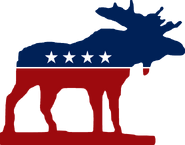
The Progressive Party, since it's foundation in October 1907, has gone on to win 45 elections, and has become in essence the most popular party in american history
After successful bidding and winning the 1906 presidential elections, Roosevelt set himself to form a new political party, the oft nicknamed "Bull Moose" party after one of Roosevelt's campaign slogans, after his Secretary of War William Howard Taft and his increasing conservative policies made the president, now battling a nationwide pandemic, ever more irate. At this point, it was believed the Taft would easily succeed Roosevelt, if ever there was little achieve with the efforts to combat the Diabetes Plague, as it was coming to be called. Roosevelt, however, felt that Taft would fail to put forward measures that would ensure the healthcare system's ability to adequately provide treatments for those scarred and crippled by the disease in the long-term. Because of this, Roosevelt sought political and financial support to found what he called "a new frontier in a barren political landscape." In March of 1908, the Progressive Party held their first convention in the Chicago Coliseum, with an attendance of 15,000 people, mostly women and those personally affected by the pandemic. A triumphant success, Roosevelt proceed for re-election in 1912 with graceful confidence and enthusiastic leverage, garnering the largest percentage of votes in any presidential election in the history of the country.
After Roosevelt's worsening health continued, he opted out of office on August 12, 1913, just before his deceased former Vice President Hiram Johnson was to be replaced after an assassination from an explosive briefcase on a train, that also caused derailment and severe wounds to the president. In contrast to Johnson, his replacement, Thomas R. Marshall held an engaging agenda in warfare participation, as opposed to Johnson's ideals as an isolationist. While Marshall had previously been reluctant in such matters, the Diabetes Plague, as he would cite, would be the main inspiration for effective control over certain components of government. On September 18, 1913, the United States declares war against the German Empire, upon the events of the Invasion of France, based itself on the assassination of the German Prince Bernhard von Bülow three weeks earlier. Roosevelt, who was bedridden at the time, strongly opposed the nation's engagement into the war, frequently refusing to eat until Congress revoked the declaration of war. Unfortunately, the war continued against his wishes, and Roosevelt, after receiving tomato soup that was administered by his personal nurse, suffered a heart attack and never recovered, at his home called Sagamore Hill in Cove Neck, New York, on July 4, 1914.
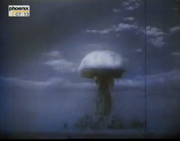
Immunoresponsive Assessment in Coxsackie Viruses or Related Pathogens. 1913-1917; World War I is sparked. Britain, America, and France gain victory four years later.
Prohibition never occurs.
Nation Searching for Alternatives[]

In 1936, cannabis is authorized for sale and distribution within the United States; with Marlboro cashing in on the new and legal recreational drug.
The Medicinal Bubble of 1935 was the combined effort of the pharmaceutical companies and the public to freely engage, practice and seek holistic alternatives to the already bloated pharmacy stockpile of various assorted medications to remedy the nation's diabetes.
Pfizer, the leading company of this field, found difficulty in offering legally produced products to those who would in turn use to synthesize their own drugs, and decided to sponsor a law that would ban any or all forms of drugs that where not authorized by the committee of the bill itself and the approved companies. An outpour of public angst lead to the bills standards being relaxed, and provided cannabis immunity, due to its high popularity among the experimentalist. On March 13, 1936, marijuana was legalized for public and private distribution. To the result, William Randolph Hurst saw a decrease in demand for lumber products from the increased hemp production, and unsuccessfully attempted to force the bill to be revoked. Cannabis use gained speed though the following decades, and in 1977, cannabis use officially surpassed the use of tobacco products, including cigarettes.
The Vocal Generation[]
The development of what came to be known as the Vocal Generation started from adolescent despondence originating from the social atmosphere after the Second World War. Primarily, it began with a group of American post-WWII writers who came to prominence in the late 1940s, as well as the cultural phenomena that they both documented and inspired. Central elements of "Vocal" culture included experimentation with drugs, alternative forms of sexuality and sexual expression, an untouched interest in Eastern religion, anarchism and/or communalism, a rejection of materialism, alternate forms of medication, and the idealizing of exuberant, unexpurgated means of expression and being. This generation was largely unwelcome to the cohort of prior generations, earning such terms and pejorative the Walktruds, Beatsteeps, Young Bums, and Leafists (for their environmentalist ideals).
Counterculture and social revolution emerges in the late 1940s (rather than the 60s), following the development of the Atomic Bomb on October 5, 1947. Beatniks = Beatsteeps, Walktruds, Leafist.
In 1968, under President Truman, the military commanders of the time thought it best to rejuvenate the fiscal budget, that was being tightened due to low international trades and exports since the Mexican Embargo, by improvising the nation's weaponry capabilities in installing several nuclear weapons programs, including the infamous Operation Prairie Dog, which not only gave the desired benefit but also brought about the creation of the effective neutron bomb. Towards the later of his term, Truman suffered from poor intergovernmental management, leading the national debt rising twofold, with public approval sinking to barely 13%. It would come to be that Truman's presidential position would be succeeded by one of the most favored candidates in American political history, when Californian Governor John Wayne sought the election of that year, and won by a large landslide, becoming the first republican president in over 36 years.
May 18, 1981 - War breaks out with Israel against Saudi Arabia, Syria and Egypt. After three years, and Cairo bombed with a neutron bomb, Israel wins the battles in each country. Israel is ejected from the UN council.
June 16, 1985, an American lands on Mars, upstaging the Soviets in the Second Space Race.
The Great Medical Struggle[]
In 1954, rising budget deficits, coupled with increasing joblessness, reduced the available governmental funds for the medical industry that produced specific medications for diabetes that would otherwise be well available for the lower class.
April 16, 1977 - After ten years since the Soviet landing, the United States finally reaches the moon in an attempt to start another Space Race.
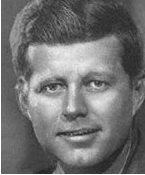
Sean P. Kennedy, the 35th president of the United States, strongly advocated universal healthcare, and received high public praise for such
1977
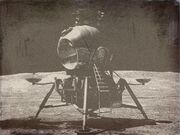
The Soviets marked their victory in the Space Race by landing on the Moon on March 13, 1967, with the United States only months behind
Modern Technology[]
Quaternary System[]
Developed in 1946 by Dr. Percival Shannon, the Quaternary system focused on a numeral pattern with a radix of four, because Dr. Shannon believed that most future computers would not handle excessive digits, yet the information contained should not be undervalued and deprecated by an inferior base system that would not condense instructional packets. The defining set was regulated by an indeterminable coefficient, thus making any information stored by the quaternary system, in dimensionless quantity, virtually unbounded and exceptionally compact. Additionally, Shannon found the logical consequencesofthequaternarysystem to be favorably diverse and expositive to his primary designs for an intricate electronic machine. Dr. Shannon was also followed closely by an esteemed competitor, whom was working on similar pursuits, and Dr. Shannon thought it best that his system be improvisational and unorthodox in its approach.

The 1973 BMT100 Computer Unit, consider by many critics to be the defining landmark in personal home computers
The categorical amounts of informational items were nicknamed pnts (points) and spyrs (spears), in where the later consisted of 16 pnts. With high interchangeability ratios, the system was adopted by most computers of the time. It would later be revised in processing method of the release of the hugely popular BMT100 computer unit in 1973, which brought many middle class homes access to previously advanced units.
The Painstaking Process of Supremacy[]
With the Soviets reaching further into the depths of space, the United States government struggled against the guerrilla movement, La Vid Roja (Spanish: "The Red Grapevine"), in the countries of Costa Rica and Panama. Originally from Guatemala, the anti-capitalistic revolutionary front, with roughly 12,000 members, had managed well within Costa Rica, being that the country had no military force of its own, and had sought interest in the self-drawn plan to "overthrown American imperialism within central American countries" by taken possession of the Panama Canal. Gregory Stanford, director of the Bureau of International and Governmental Intelligence (BIGI), addressed President Wayne of the "increasing need to insure present and future American interest" by forming a military blockade at the Panama Canal. On March 1, 1971, despite recent measures in favor of Stanford's recommendations by the U.S. government, the La Vid Roja front took hold the shipping canal and forced the Panama Canal Authority to resign the territory to their cause. Later that afternoon, the United States declared war against the La Vid Roja and their allies, beginning with the Invasion of Panama at 7:02 p.m. that evening.
Moral Turpitude[]
The later of the seventies showed no visible signs of political undergoing until the discovery and arrest of five members of the Naval Staff at the Spring & Burns law firm on Pennsylvania Avenue sparked perplexity and demanding questions to the current government headed by Harlen Nixon from the disquieted American public after it had been found that the documents that where being unlawfully acquisitions pertained to the recent court case against the Maloni crime syndicate. Nixon’s explanations regarding his, and his administration's, non-involvement in any fashion, served as a temporary situation reliever, until a mild-mannered New Yorker journalist, by the name of Dennis Spengler, let loose the facts pertaining to the administration’s activities from numerous credible sources and bank statements, including, but not restricted to: Investments in PharmX secret program in excessive fluoridation of the public water system to bring test scores down in children of “less opportune backgrounds,” erasure of financial records from senior citizen programs to healthcare, insider trading and illegal gambling with many staff members accountable, and direct involvement in the Spring & Burns scandal; with many personal memos from, and directed to, the president himself.
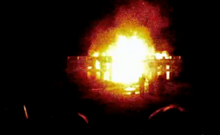
John Alderman's on-the-scene photograph of the burning White House, as the Washington fire department battles the flames, after the infamous solo attack by Arron Grib on November 9, 1977
Shortly after airing on CBSN, over two thousand angry citizens took to the streets outside the White House, it what became the largest public demonstration, and later riot, outside the lawn in American history at the time. The president suffered and was dealt much humiliation, as his approval rating plummeted down to 2%. The Chief of Staff resigned after being assaulted by one of his bodyguards. The public informer, Donald Greensort, was arrested for crimes against the government, specifically for the unauthorized release of top secret material regarding the war effort. Greensort, who was an advocate in homemade psycho-stimulants and strongly observant of Marxist-Leninism, did not favor highly with the common public, in terms of character, yet was extremely well regarded for his unrelenting journalism and moral conviction in his expertise. After the suicide of the White House Press Secretary due to overdosing on his expired diabetes medication, Nixon fated his resignation in the midst of impeachment and public outcry. Making the announcement later in the evening on November the 3rd, a Washingtonian salesman and writer Arron Grib sought to catch the president “before he made a run for the hills” by hatching an assassination plan involving a twin-engine carrier jet, a .38 revolver, and an unprotected fencing sword. On November 9, after scarce preparations within a few days, Grib headed to Herald International Airport at 3:59 p.m., with the successful incentive to hijack the desired plane and crash it into the Oval Office with Nixon in it. For the second time in history, the White House burned. By 5 o’clock, surviving White House member, President Pro Tempore of the Senate Johann Dickerson, was sworn in as the presidential successor, only to have to resign four hours later.
Before leaving, Dickerson placed the Secretary of State, Steven John Jay, as the next acting president, to which Jay committed suicide (the only president to do so) exactly two weeks later, leaving the government of the nation in a power vacuum after failed attempts to acquire a position-holding replacement that accepts the entitlement. On October 3, 1977, General Arthur MacArthur IV declared martial law and an immediate halt to all governmental activities in what he called " ...the most unsure 'falls from grace' of our time." Placing the Secretary of Defense Alaric Franz Moltke as his 'vice president TemporaIre', MacArthur sought complete control of all governmental undergoing's for the next three years until the next presidential elections. The senate initially accepted his offer, yet declined his objectives in complete control of their branch. By early August of 1978, the Senate had forced impeachment on the five-star general and president Temporaire, to the rousing suspicions of foul play in the recent deaths of his economic advisors in a fatal bus crash two months prior. The proceedings went to plan on the 12th of September, to which MacArthur resigned his post and disbanded his hand-picked administration; organizing public elections for end of the month. On September 31,
The Kennedy Administration brought along with it high anxiety and speculation on the nation's future, to the result of where the American film industry reflected that unassuredness.
Modern Era[]

Pillar Architecture, founded in 1969, has become the world's largest architecture firm, amassing over $2.3 trillion in annual revenue in over 190 countries
The Rise of Samori Christian and Nationalist Republic of West Africa[]
Early years of Christian[]
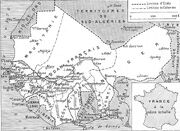
From 1895, France held power and influence over seven colonies, which comprised West Africa
In the smallest of villages near Yamoussoukro, a young boy was coming to terms with the death of both his parents to Cholera. Finding refugee in the numerous makeshift tents posted across the country in order to quell any outbreaks and to observe any emergences of Coxsackie mutations in this sickened corner of the world, this introverted child was treated for a high fever, and after passing the IA-CVRP test, yielding negative for diabetes, he was set to an underfunded missionary to be taught French, where he received the surname Christian. The overly healthy student would become infamously known as Samori Christian.
After entering secondary school at 16, Christian decided rather to join the army, hoping for more action in his life. He was not the best of students, but he proved to be the most observant soldier. Acquiring the rank of Sergeant by the age of 21, he quickly moved up in the military hierarchy, until he settled at the position of First Lieutenant at the still youthful age of 28.
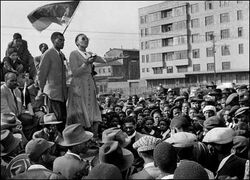
Samori Christian and his first wife representing the United Front to a public crowd in 1953, just before Christian's accession to military leader of the group
The French had dominated the surrounding lands of West Africa for the good part of the century, and with it came high levels of discontentment amongst the natives, some even forming ideas of retaking their stolen motherland. Christian found himself associating with these perceived radicals and was welcomed due to his influential status in the military. His superior, Captain Arnaud LePointe, took the young lackey under his wing, yet constantly reminded him that this was the end of the line for him due to his 'background'. Distasteful of this racism, Christian secretly joined the United Front, an anti-colonialist group, and sought their favor by promising military support to their cause.
The group had already caused a stir in the region, and had won many soldiers interest. Those who Christian supervised also had affiliation to the group. With preparations in order, Christian entered the room of his superior during an Autumn night in 1953, and murdered him while he slept in a chair in his bathrobe. Promoted to Captain hastily while the murder was under investigation, Christian avoided suspicion, and proceed to lead his soldiers to overtake the capital, Abidjan.
Upon entering the capital with little over 2,000 soldiers, Christian proved to be just as good as a Captain, as he was an orator. Broadcasting daily messages over the local radio, he convinced thousands of city-folk to support his cause against colonialism. Amassing later an army of twenty-five thousand, he gained victory in Abidjan after two weeks, and promoted himself to General of the United Front.
Siege of Dakar[]
For the following three years, he continued to gain influence as he approached the capital of the French West Africa, Dakar. By then, his popularity had struck a chord with the general public, and a nerve with the French government. Surprise attacks where often staged against the invading army, much to Christian's chagrin. Hearing of Italy's attempts at fascism, he became interest at the thought of forming his government under such a political ideology, thinking it would bring about a strong economy and his own security within his tenure as ruler of the nation. He began by watching educational films on fascism, and then showed these reels to his officers. His armies arrived at the borders of the city on April 15, 1956, and Christian was immediately faced with the French Army. The siege commenced and lasted for two months, before France relinquished authority over West Africa to the United Front, soon after entering the capitol building on June 15. This was coupled with the effort by many cities in achieve independence from France, in which at least 25 movements were held in cities such as Saint Louis, Niamey, and Conakry.

The flag of the Nationalist Republic of West Africa, governed by a fascist dictatorship, and is the largest and most powerful nation on the African continent.
On that day, Christian rounded up his advisors, and declared the entire former French territory under the new government and name of Nationalist Republic of West Africa. With utmost quickness, Christian instituted absolute rule as Head General of the Armed Forces, and the leader of the nation. Developed countries to the north, such as England and Belgium, became concerned over France's apparent lack of ability to quell the rising revolution. These nations would later face other movements of decolonization, albeit in less forceful measures.
Later years and death[]
Increasingly troubled by the threat of assassination, Christian became eccentrically paranoid, often to the point of shooting his officers on a whim during meetings with them. While business negotiations with the Sudanese where improving greatly, Christian thought it best that the nation be "wiped out" in order to recover their natural resources. Christian made the matter of military importance, rather than commercial, when he declared war with Sudan on June 7, 1978. The invasion was largely land based, while air-strikes to the nation's capital occur infrequently. With the manpower of 550,000 combatants, victory for West Africa was all but inevitable, against the meager 28,000 of Sudan army. The capital was overcome by three weeks, and surrender was issued on August 2.

While even Dakar boast little wealth over the rest of the country, it's skies suffer from noxious fumes from the nearby chemical and industrial plants
This success in Sudan saw major innovation in the industrial section, with the economy growing steadily by 4.5% per year. By the 1980s, West Africa had gained the political influence to be considered a 'great power' in the modern world, having not only the largest territory in the continent, but also the largest economy and standing army. However, West Africa still had one of the poorest health care infrastructure of any developed country, with over five million citizens being untreated for diabetes. Dr. Léopold Sédar Senghor, one of Christian's political advisors, urged him to settle the nation's healthcare problem before it cause the government to be thrown into financial ruin. Christian offhandedly dismissed Dr. Senghor statements, saying "nobody likes bad news". Unyielding, Dr. Senghor convinced Christian of the civil unrest that would arise if the nation did not receive treatments for their diabetes. In June 1981, an effective healthcare plan was issued for all those seeking therapy to their health problems. Within five years, the program was a failure, and Dr. Senghor had disappeared two years earlier.
While watching an American cowboy movie, Christian was struck on the back of the head with a butcher's knife, by his personal chief for two years, during a warm summer night on June 7, 1987. Christian's guards found his body fifteen minutes afterward, and immediately rushed him to hospital where he was pronounced dead. {C {C The cook was found and executed that very night, and Christian's Brigadier Alson Haburak took control of the nation. Riots erupted in large cities across the nation in outrage of their leader's demise, which lasted for more than two weeks.
The Multipolar Political World Map[]
By the latter half of the 20th century, the political world had no particular alignment to any superpower, more so five great powers, each influencing matters on each of their continents, and two superpowers: United States and the Soviet Union.

